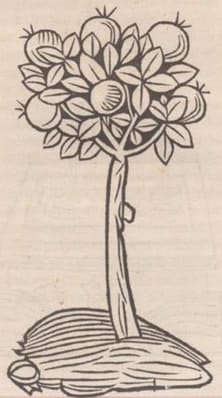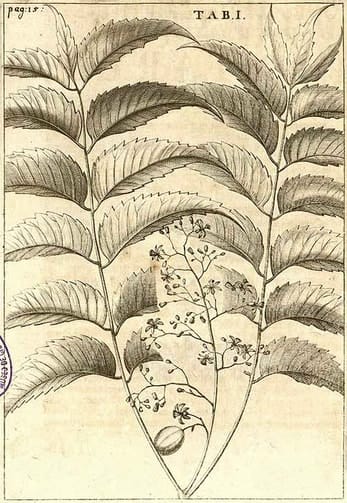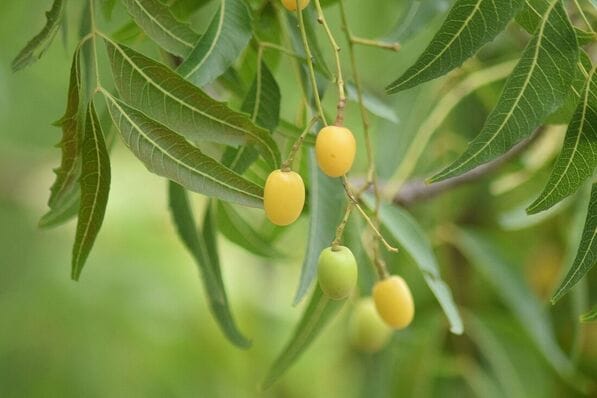Azadirachta, Neem, NimbaMargosa treeNimba, Nimbaka, Arishta (Ayurveda) Neem, Aazaad-Darakht-e-Hindi (Unani) Vemmu, Vembu, Veppan (Siddha) Nim Pa ནིམ་པ (Tibetan) |

|

|
 ‘Azeadarach’, Ortus sanitatis,
‘Azeadarach’, Ortus sanitatis,Cube, Johann von, 1501
 Prodromi fasciculi rariorum plantarum,
Prodromi fasciculi rariorum plantarum,Breyne, 1739
 (Photo by Jimmy tikhak) (Wikimedia)
(Photo by Jimmy tikhak) (Wikimedia) Members CLICK HERE for the PRO VERSION
Members CLICK HERE for the PRO VERSIONBotanical name:
Azadirachta indica (syn. Melia azadirachta)
Parts used:
Leaf, Bark, Seed oil, Fruit (less commonly); all parts of the plant are used in Folk Medicine
Temperature & Taste:
Cool, dry. Bitter
Classifications:
2F. PURIFYING
3Q. ANTHELMINTIC
TCM:
S. WORMS & PARASITES
Uses:
1. Clears Heat and Poison (Bark; Ayurveda; Tibetan, Unani):
-High Fever; Chronic Fever; Malarial Fever; Dengue Fever; Postpartum Fever (usually bark)
-Measles, Small Pox (leaf, bark)
-Poisoning
-Boils, Abscesses
-Hot-phlegm Cough; fruit has also been given in Bronchitis
2. Clears Heat from the Blood (Leaf; Ayurveda, Unani, Tibetan):
-skin conditions from excess Bile and Blood Heat
-Skin diseases, Eczema, Psoriasis, Erysipelas, Leprosy; Burning Sensations
-Inflammatory conditions of the Uterus
-regarded as an excellent Blood purifier in Ayurveda, Unani, and Tibetan Medicine
3. Clears Stomach Heat:
-Hyperacidity, Stomach Ulcers (Leaf)
-Thirst (Tibet)
-Colitis, Crohn’s Disease
4. Clears Damp-Heat, Promotes Urine:
-Urinary discharges
-Edema, Ascites
-Neem oil has been found beneficial in Diabetic patients (relieved itching, indigestion, tiredness, increased wound healing)
5. Kills Worms:
-Worms; Ascaris, Helminthiasis (leaf, bark, fruit)
6. Anti-Fertility:
-Neem oil has been showed to have anti-fertility effects on males and females; it is spermicidal.
7. Externally:
-all fungal and bacterial skin diseases (oil topically)
-inflammations of the mouth and throat; Toothache (leaf infusion as a wash)
-the fresh twigs are chewed and used to cleanse the teeth and gums; used in Toothpastes
-leaf juice or strong infusion as an eyewash for red, sore, inflamed eyes, Conjunctivitis; also Night-blindness
-Oil is used topically for Ulcers
-Paste or Oil is applied to Ringworm, Skin disease, Ulcers and Leprosy
-in compound oils for rheumatism, arthritis, hemiplegia, paralysis
-Fissures, Fistulas and Hemorrhoids
-strong wash or the oil is used to kill Lice
-Mosquito repellent (oil, 5% dilution)
-used in soaps and shampoos
-used as an insecticide in home and garden
Dose:
Powder of the Bark: 500mg–4 grams;
Decoction of the Bark: 3–9 grams
Powder of the Leaf: 500mg–2 grams
Powder of the Seed: 200–500mg
Correctives:
… available in PRO version

Main Combinations:
1. Skin diseases:
i. Neem is often combined with … available in PRO version
ii. Neem, … available in PRO version
iii. Neem, … available in PRO version
iv, Neem, … available in PRO version
v. Neem, … available in PRO version
vi. Neem, … available in PRO version
vii. Neem, … available in PRO version
viii. Neem, … available in PRO version
ix. Neem, … available in PRO version
x. Neem, … available in PRO version
xi. from Wind-Phlegm, Neem, … available in PRO version
xii. Neem with … available in PRO version
xiii. Neem, … available in PRO version
xiv. Inflammatory skin conditions, Neem, with … available in PRO version
2. Acne, Neem, … available in PRO version
8.. Blood Heat, Neem, … available in PRO version
4. Inflammation from Damp-Heat (Phlegm-Bile), Neem with … available in PRO version
5. As a blood purifier in Scabies, Abscess and Syphilis, Neem with … available in PRO version
6. Fever:
i. from mixed Humors, Neem, … available in PRO version
ii. from Damp-Heat (Phlegm-Bile), Neem, … available in PRO version
7. Hepatitis, Liver inflammation from excess Bile (Pitta):
i. Neem, … available in PRO version
ii. Neem, … available in PRO version
iii. Neem, … available in PRO version
8. Liver congestion with Heat, Neem, … available in PRO version
9. Intestinal Inflammations, Neem with … available in PRO version
10. Lung Heat Cough, Bronchitis:
i. Neem, … available in PRO version
ii. Neem, … available in PRO version
11. Diabetes:
i. Neem with … available in PRO version
ii. Neem, … available in PRO version
iii. Neem with … available in PRO version
12. Mouth inflammations, Ulcers, Neem with … available in PRO version
13. Intermittent Fever, Neem with … available in PRO version
14. Worms and Parasites:
i. Neem with … available in PRO version
ii. Neem with … available in PRO version
15. Infections, Neem with … available in PRO version
16. As a wash for Fungal infections, Neem with … available in PRO version
17. Hemorrhoids, Neem, … available in PRO version
18. Topically for Heat and Inflammation, Neem with … available in PRO version
Cautions:
1. Wind constitution or Yin deficiency (very bitter and drying)
2. Not used in Cold symptoms.
3. Wasting, deficiency or weakness
4. Pregnancy or those wanting to become pregnant
Main Preparations used:
Oil
History
|
‘This tree, in Sanskrit Nimba, is a native of India, and is cultivated in all parts of the country on account of its medicinal properties. The leaves, bark and other products of the Nim have been articles of the Hindu Materia Medica from a very remote period, and are mentioned in the Ayurvedas of Susruta. The bark is considered to be bitter, tonic, and astringent. The leaves are added to poultices to disperse glandular tumours, and are used generally as a discutient; beaten into a pulp they are applied to pustular eruptions, more especially to the eruption of small-pox; their juice is anthelmintic, and is given in a variety of diseases, such as jaundice, purigo, boils, &c. Chakradatta recommends a poultice of the leaves mixed with Sesamum seeds for unhealthy ulcerations. The fruit is described as purgative, emollient, and anthelmintic. The oil of the seeds is applied to suppurating scrofulous glands, is given in leprosy, and a variety of diseases. The gum is said to have stimulant properties. The young trees tapped yield a saccharine juice, which when fermented is used as a stomachic ; several observers have noticed that in certain years this juice appears to flow with unusual abundance. The air waved with a Nim branch is supposed to be a cure for syphilis, hence the Hindustani saying— “Khuda kare nim ki tahni hath men ho.” “May God place a nim branch in his hand.” Anglice,—”A pox take him.” The insane are passed through a cleft of the tree or a stem which having parted and reunited forms a circular opening. This useful tree naturally attracted the attention of the Mahometans upon their arrival in the country, and they named it Azaddarakht-i-Hindi, from its resemblance to the Melia Azedarach or Persian lilac. |
The author of the Makhzan-el-Adwiya is careful to point out that the Indian Nim is not found in Persia. He describes the Nim and Azadarakht separately, giving Bakayan as the Indian name for the latter. The quotation from the Makhzan in the Bengal Dispensatory appears to be incorrect, as I can find no such statement under the articles Nim or Azaddarakht. The Mahometans use the different products of the Nim in the same manner as the Hindus, and like them consider it to be cold and dry. Amongst European physicians, Dr. White, of Bombay, has recommended the bark as a febrifuge; others have spoken favourably of the leaves as a local application to ulcers and certain obstinate skin diseases. Dr. Hove (1787) thus speaks of the Nim tree:— “The Gentoos here worship this tree, and their barren women invoke and perform the same ceremonies round it every morning as they usually do in the other Pergunnahs about the Ficus religiosa. The leaves are of a powerful bitter, and they use a strong decoction with great success in intermittents, and which I usually drank for my liver complaint and found myself much relieved by it.” He also notices the use of the gum by lying-in women.— (Hove, account of Mitampoor.) From recent experience detailed in the Pharmacopoeia of India, it would appear that the opinion of the natives of India regarding the medicinal properties of the different parts of this tree is substantially correct. The bark is now official in the above-mentioned Pharmacopoeia.’ (Vegetable Materia Medica of Western India, Dymock, 1885) |
